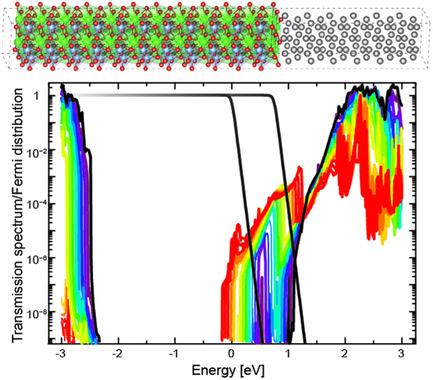当前位置:
X-MOL 学术
›
Adv. Electron. Mater.
›
论文详情
Our official English website, www.x-mol.net, welcomes your
feedback! (Note: you will need to create a separate account there.)
A Theoretical and Experimental View on the Temperature Dependence of the Electronic Conduction through a Schottky Barrier in a Resistively Switching SrTiO3‐Based Memory Cell
Advanced Electronic Materials ( IF 5.3 ) Pub Date : 2018-06-14 , DOI: 10.1002/aelm.201800062 Carsten Funck 1 , Astrid Marchewka 1 , Christoph Bäumer 2 , Peter C. Schmidt 3 , Phillip Müller 2 , Regina Dittmann 2 , Manfred Martin 4 , Rainer Waser 1, 2 , Stephan Menzel 2
Advanced Electronic Materials ( IF 5.3 ) Pub Date : 2018-06-14 , DOI: 10.1002/aelm.201800062 Carsten Funck 1 , Astrid Marchewka 1 , Christoph Bäumer 2 , Peter C. Schmidt 3 , Phillip Müller 2 , Regina Dittmann 2 , Manfred Martin 4 , Rainer Waser 1, 2 , Stephan Menzel 2
Affiliation

|
Metal–semiconductor Schottky interfaces are of high interest in many fields of semiconductor physics. One type of electronic devices based on Schottky contacts are resistive switching cells. The mostly applied analytical models are insufficient to describe all Schottky contact systems, which further impedes finding the correct conduction mechanism and may lead to physical misunderstandings. In this work, the electron transport properties of the resistively switching SrTiO3/Pt interface model system are investigated using a combination of experimental and theoretical methods. Temperature‐dependent I–V curves are measured and analyzed using an analytical approach, an atomistic approach based on density functional theory and the nonequilibrium Green's function formalism, and a continuum modeling approach. The findings suggest two different conduction mechanisms. Instead of a current transport over the barrier, as in the case of Schottky emission theory, the simulations show that tunneling through the Schottky barrier dominates. In the low voltage range, only thermally excited electrons can tunnel into the conduction band. For higher voltages, the SrTiO3 conduction band and the Fermi level at the injecting Pt‐electrode are aligned, allowing also electrons at the Fermi‐edge to tunnel. Consequently, the temperature dependence changes, leading to a crossing of the I–V curves at different temperatures.
中文翻译:

基于电阻切换基于SrTiO3的存储单元中通过肖特基势垒的电子传导的温度依赖性的理论和实验观点
在半导体物理学的许多领域中,金属-半导体肖特基界面引起了人们的极大兴趣。基于肖特基接触的一种电子设备是电阻开关单元。应用最广泛的分析模型不足以描述所有的肖特基接触系统,这进一步阻碍了寻找正确的导电机制并可能导致物理上的误解。在这项工作中,结合实验和理论方法研究了电阻切换SrTiO 3 / Pt界面模型系统的电子传输性能。温度相关的IV使用分析方法,基于密度泛函理论和非平衡格林函数形式主义的原子方法以及连续模型方法对曲线进行测量和分析。这些发现提示了两种不同的传导机制。模拟表明,通过肖特基势垒的隧穿起主导作用,而不是像肖特基发射理论那样通过势垒进行电流传输。在低电压范围内,只有热激发的电子可以隧穿到导带中。对于更高的电压,注入的Pt电极上的SrTiO 3导带和费米能级是对齐的,这也使得费米边缘的电子也可以隧穿。因此,温度依赖性发生变化,导致I – V相交 不同温度下的曲线。
更新日期:2018-06-14
中文翻译:

基于电阻切换基于SrTiO3的存储单元中通过肖特基势垒的电子传导的温度依赖性的理论和实验观点
在半导体物理学的许多领域中,金属-半导体肖特基界面引起了人们的极大兴趣。基于肖特基接触的一种电子设备是电阻开关单元。应用最广泛的分析模型不足以描述所有的肖特基接触系统,这进一步阻碍了寻找正确的导电机制并可能导致物理上的误解。在这项工作中,结合实验和理论方法研究了电阻切换SrTiO 3 / Pt界面模型系统的电子传输性能。温度相关的IV使用分析方法,基于密度泛函理论和非平衡格林函数形式主义的原子方法以及连续模型方法对曲线进行测量和分析。这些发现提示了两种不同的传导机制。模拟表明,通过肖特基势垒的隧穿起主导作用,而不是像肖特基发射理论那样通过势垒进行电流传输。在低电压范围内,只有热激发的电子可以隧穿到导带中。对于更高的电压,注入的Pt电极上的SrTiO 3导带和费米能级是对齐的,这也使得费米边缘的电子也可以隧穿。因此,温度依赖性发生变化,导致I – V相交 不同温度下的曲线。











































 京公网安备 11010802027423号
京公网安备 11010802027423号